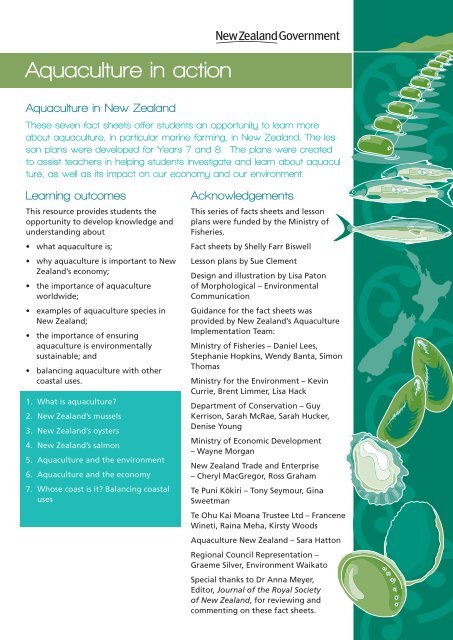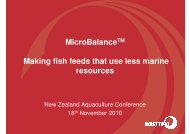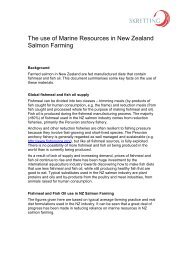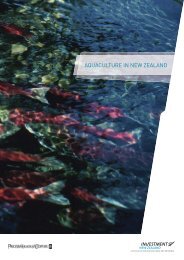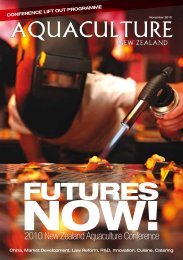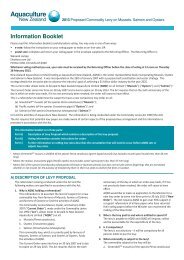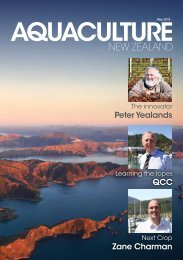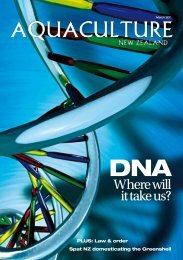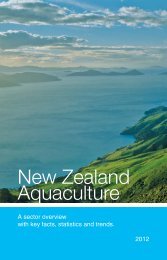Aquaculture in Action Fact Sheets - Ministry of Fisheries
Aquaculture in Action Fact Sheets - Ministry of Fisheries
Aquaculture in Action Fact Sheets - Ministry of Fisheries
Create successful ePaper yourself
Turn your PDF publications into a flip-book with our unique Google optimized e-Paper software.
FACTSHEET<br />
<strong>Aquaculture</strong> <strong>in</strong> action<br />
<strong>Aquaculture</strong> <strong>in</strong> New Zealand<br />
These seven fact sheets <strong>of</strong>fer students an opportunity to learn more<br />
about aquaculture, <strong>in</strong> particular mar<strong>in</strong>e farm<strong>in</strong>g, <strong>in</strong> New Zealand. The lesson<br />
plans were developed for Years 7 and 8. The plans were created<br />
to assist teachers <strong>in</strong> help<strong>in</strong>g students <strong>in</strong>vestigate and learn about aquaculture,<br />
as well as its impact on our economy and our environment.<br />
Learn<strong>in</strong>g outcomes<br />
This resource provides students the<br />
opportunity to develop knowledge and<br />
understand<strong>in</strong>g about<br />
• what aquaculture is;<br />
• why aquaculture is important to New<br />
Zealand’s economy;<br />
• the importance <strong>of</strong> aquaculture<br />
worldwide;<br />
• examples <strong>of</strong> aquaculture species <strong>in</strong><br />
New Zealand;<br />
• the importance <strong>of</strong> ensur<strong>in</strong>g<br />
aquaculture is environmentally<br />
susta<strong>in</strong>able; and<br />
• balanc<strong>in</strong>g aquaculture with other<br />
coastal uses.<br />
1. What is aquaculture<br />
2. New Zealand’s mussels<br />
3. New Zealand’s oysters<br />
4. New Zealand’s salmon<br />
5. <strong>Aquaculture</strong> and the environment<br />
6. <strong>Aquaculture</strong> and the economy<br />
7. Whose coast is it Balanc<strong>in</strong>g coastal<br />
uses<br />
Acknowledgements<br />
This series <strong>of</strong> facts sheets and lesson<br />
plans were funded by the M<strong>in</strong>istry <strong>of</strong><br />
<strong>Fisheries</strong>.<br />
<strong>Fact</strong> sheets by Shelly Farr Biswell<br />
Lesson plans by Sue Clement<br />
Design and illustration by Lisa Paton<br />
<strong>of</strong> Morphological – Environmental<br />
Communication<br />
Guidance for the fact sheets was<br />
provided by New Zealand’s <strong>Aquaculture</strong><br />
Implementation Team:<br />
M<strong>in</strong>istry <strong>of</strong> <strong>Fisheries</strong> – Daniel Lees,<br />
Stephanie Hopk<strong>in</strong>s, Wendy Banta, Simon<br />
Thomas<br />
M<strong>in</strong>istry for the Environment – Kev<strong>in</strong><br />
Currie, Brent Limmer, Lisa Hack<br />
Department <strong>of</strong> Conservation – Guy<br />
Kerrison, Sarah McRae, Sarah Hucker,<br />
Denise Young<br />
M<strong>in</strong>istry <strong>of</strong> Economic Development<br />
– Wayne Morgan<br />
New Zealand Trade and Enterprise<br />
– Cheryl MacGregor, Ross Graham<br />
Te Puni Kökiri – Tony Seymour, G<strong>in</strong>a<br />
Sweetman<br />
Te Ohu Kai Moana Trustee Ltd – Francene<br />
W<strong>in</strong>eti, Ra<strong>in</strong>a Meha, Kirsty Woods<br />
<strong>Aquaculture</strong> New Zealand – Sara Hatton<br />
Regional Council Representation –<br />
Graeme Silver, Environment Waikato<br />
Special thanks to Dr Anna Meyer,<br />
Editor, Journal <strong>of</strong> the Royal Society<br />
<strong>of</strong> New Zealand, for review<strong>in</strong>g and<br />
comment<strong>in</strong>g on these fact sheets.<br />
<strong>Fact</strong> sheets
Glossary<br />
Here you’ll f<strong>in</strong>d a few <strong>of</strong> the terms that are used <strong>in</strong> the <strong>Aquaculture</strong> <strong>Fact</strong> <strong>Sheets</strong>.<br />
Anadromous – animals that are spawned <strong>in</strong><br />
fresh water, migrate to sea to live and return to<br />
freshwater to spawn.<br />
<strong>Aquaculture</strong> – the rais<strong>in</strong>g <strong>of</strong> plants or animals <strong>in</strong><br />
water. It can occur <strong>in</strong> coastal waters, rivers, lakes,<br />
and even on land – <strong>in</strong> constructed pools or tanks.<br />
Bivalves – animals that are <strong>in</strong> the phylum Mollusca<br />
that have two valves (shells). Mussels, cockles, and<br />
oysters are just some <strong>of</strong> the molluscs that are <strong>in</strong> this<br />
class.<br />
Customary fish<strong>in</strong>g – fish<strong>in</strong>g is culturally important<br />
for many iwi and hapü. New Zealand has customary<br />
fish<strong>in</strong>g regulations <strong>in</strong> place to ensure that iwi and<br />
hapü are able to manage their customary fish<strong>in</strong>g<br />
practices.<br />
Depuration – the process <strong>of</strong> remov<strong>in</strong>g impurities<br />
from shellfish by leav<strong>in</strong>g them for a period <strong>of</strong> time<br />
<strong>in</strong> a clean supply <strong>of</strong> water.<br />
Greenshell mussels (Perna canaliculus) – are grown<br />
only <strong>in</strong> New Zealand. The stands for trademark.<br />
Greenshell mussels are trademarked so people can<br />
tell they were grown <strong>in</strong> New Zealand.<br />
Environmental susta<strong>in</strong>ability – us<strong>in</strong>g natural<br />
resources <strong>in</strong> a way that ensures that ecological<br />
processes are ma<strong>in</strong>ta<strong>in</strong>ed and not compromised for<br />
future generations.<br />
Export – <strong>in</strong> economics, export is used to describe<br />
when a consumer good or service is legally<br />
transported from one country to another for the<br />
purposes <strong>of</strong> trade.<br />
Foreshore – is the land that is regularly covered<br />
by the tide (the wet part <strong>of</strong> the beach). It<br />
<strong>in</strong>cludes land covered by high tides, the space<br />
occupied by the air and water above the land,<br />
and the soil and rock under it. (Source: Mark<br />
Hickford. ‘Law <strong>of</strong> the foreshore and seabed’,<br />
Te Ara – the Encyclopedia <strong>of</strong> New Zealand,<br />
updated 21-Sep-2007. http://www.TeAra.govt.<br />
nz/EarthSeaAndSky/OceanStudyAndConservation/<br />
LawOfTheForeshoreAndSeabed/en)<br />
Fry – young fish.<br />
Hydrocolloids – large, water soluble molecules <strong>in</strong><br />
seaweeds. When extracted hydrocolloids can be<br />
used for their stabilis<strong>in</strong>g and gell<strong>in</strong>g properties.<br />
Kaimoana – food from the sea.<br />
Kaitiakitanga – guardianship <strong>of</strong> natural resources.<br />
Krill – are small shrimp-like mar<strong>in</strong>e <strong>in</strong>vertebrate<br />
animals.<br />
Larva – the early form <strong>of</strong> an animal before it<br />
matures or reaches the next developmental stage.<br />
Mar<strong>in</strong>e farm<strong>in</strong>g – aquaculture that occurs <strong>in</strong> the<br />
mar<strong>in</strong>e environment.<br />
Mollusc – mar<strong>in</strong>e animals <strong>of</strong> the phylum Mollusca.<br />
In Lat<strong>in</strong> the word molluscus means s<strong>of</strong>t. Common<br />
features that molluscs share <strong>in</strong>clude s<strong>of</strong>t,<br />
unsegmented bodies.<br />
Ocean ranch<strong>in</strong>g – is a type <strong>of</strong> mar<strong>in</strong>e farm<strong>in</strong>g<br />
where juvenile fish are released <strong>in</strong>to the ocean to<br />
grow unprotected and unassisted until they are<br />
harvested. In New Zealand there were several<br />
attempts to ocean ranch salmon.<br />
Phylum – the second largest taxonomic division <strong>of</strong><br />
the animal k<strong>in</strong>gdom. Animals with<strong>in</strong> a phylum will<br />
all have some basic similarities.<br />
Plankton – are microscopic plants and animals<br />
found drift<strong>in</strong>g <strong>in</strong> mar<strong>in</strong>e and freshwater<br />
environments.<br />
Salmonid – a member <strong>of</strong> the Salmonidae family <strong>of</strong><br />
fish, <strong>in</strong>clud<strong>in</strong>g salmon and trout.<br />
Seabed – is the land that is underwater completely<br />
(the sea around the coast). (Source: Mark<br />
Hickford. ‘Law <strong>of</strong> the foreshore and seabed’,<br />
Te Ara – the Encyclopedia <strong>of</strong> New Zealand,<br />
updated 21-Sep-2007 http://www.TeAra.govt.<br />
nz/EarthSeaAndSky/OceanStudyAndConservation/<br />
LawOfTheForeshoreAndSeabed/en)<br />
Smolt – juvenile fish that are ready to leave a<br />
freshwater environment and migrate to the ocean.<br />
Spat – very young shellfish.<br />
Spawn – to produce or deposit eggs or sperm.<br />
Species – a group <strong>of</strong> plants or animals that when<br />
they <strong>in</strong>terbreed are able to produce fertile<br />
<strong>of</strong>fspr<strong>in</strong>g.<br />
Water quality – is a measure <strong>of</strong> the suitability <strong>of</strong><br />
water for different uses. To measure water quality,<br />
scientists test water and compare the test results to<br />
a set <strong>of</strong> established standards.
FACTSHEET<br />
1<br />
<strong>Aquaculture</strong> <strong>in</strong> action<br />
What is aquaculture<br />
When you fly over New Zealand you can see a patchwork <strong>of</strong> work<strong>in</strong>g<br />
farms – from apple orchards to deer farms to dairy farms to forests. As<br />
you fly over the coastal waters <strong>of</strong> our island nation you might also see<br />
mar<strong>in</strong>e farms.<br />
Mussel farm. Photo: New Zealand Seafood<br />
Industry Council<br />
Mar<strong>in</strong>e farm<strong>in</strong>g is a type <strong>of</strong> aquaculture.<br />
<strong>Aquaculture</strong> is simply the rais<strong>in</strong>g <strong>of</strong> plants<br />
or animals <strong>in</strong> water. It can occur <strong>in</strong> coastal<br />
waters, rivers, lakes, and even on land<br />
– <strong>in</strong> constructed pools or tanks.<br />
People have been <strong>in</strong>volved <strong>in</strong><br />
aquaculture s<strong>in</strong>ce ancient times. In<br />
Hawaii constructed fish ponds dat<strong>in</strong>g back<br />
at least 1000 years have been identified.<br />
Accord<strong>in</strong>g to Polynesian legend, one pond<br />
<strong>in</strong> Hawaii was built by mythological elf-like<br />
people called Menehune.<br />
Stories about the Menehune and their many great feats were told throughout<br />
Polynesia. Mäori legends refer to these forest-dwell<strong>in</strong>g creatures as Patupaiarehe.<br />
Why aquaculture<br />
<strong>Aquaculture</strong> is thought to be the fastestgrow<strong>in</strong>g<br />
type <strong>of</strong> food production <strong>in</strong> the<br />
world.<br />
One <strong>of</strong> the ma<strong>in</strong> reasons for this is that the<br />
world wild fish catch has levelled <strong>of</strong>f or<br />
decl<strong>in</strong>ed. The most recent global assessment<br />
<strong>of</strong> wild mar<strong>in</strong>e fish stocks <strong>of</strong> the Food and<br />
Agriculture Organization <strong>of</strong> the United<br />
Nations (FAO) found that out <strong>of</strong> the nearly<br />
600 species it monitors over 75 per cent<br />
were be<strong>in</strong>g fished to capacity or were overharvested.<br />
Villagers <strong>of</strong> the picturesque Andaman<br />
island known as Panyee tend fi sh they are<br />
rais<strong>in</strong>g <strong>in</strong> cages. Once harvested, these fi sh<br />
will be sold to supply the restaurants cater<strong>in</strong>g<br />
to tourists <strong>in</strong> nearby Phuket. Country:<br />
Thailand. Photo: © FAO/24553/R. Faidutti<br />
With some fish becom<strong>in</strong>g harder to f<strong>in</strong>d or<br />
more expensive to catch, it is sometimes<br />
cheaper and easier to farm some species<br />
<strong>in</strong>stead. Over a third <strong>of</strong> all seafood eaten <strong>in</strong> the world today has been raised on<br />
farms. In the United States, two <strong>of</strong> the top ten seafoods eaten <strong>in</strong> 2006 are only<br />
raised on farms – tilapia and catfish. In New Zealand, all the fresh mussels, salmon<br />
and Pacific oysters we eat are grown on farms here.<br />
Many people predict that aquaculture development <strong>in</strong> the 21st century will be<br />
similar to how agriculture – farm<strong>in</strong>g on land – grew <strong>in</strong> the 20th century. Some <strong>of</strong><br />
the reasons people believe aquaculture has potential for growth <strong>in</strong> New Zealand<br />
are because we have over 15,000 kilometres <strong>of</strong> coastl<strong>in</strong>e, cool enough waters to<br />
raise a wide range <strong>of</strong> species, and a clean environment.
More than fish and chips<br />
Hunger is still an issue <strong>in</strong> many parts<br />
<strong>of</strong> the world. Researchers with the<br />
FAO believe that aquaculture has<br />
an important role to play <strong>in</strong> directly<br />
provid<strong>in</strong>g a nutritional source <strong>of</strong><br />
food, as well as provid<strong>in</strong>g jobs and<br />
<strong>in</strong>come.<br />
Foods like rice, wheat, corn and<br />
cassava are the ma<strong>in</strong> sources <strong>of</strong> food<br />
for many poor people around the<br />
world. While these staple foods are<br />
important they do not provide people<br />
with all the nutrition they need to<br />
lead a healthy life. Seafood is rich <strong>in</strong><br />
prote<strong>in</strong>, essential fatty acids, vitam<strong>in</strong>s<br />
and m<strong>in</strong>erals that some people might<br />
not otherwise get <strong>in</strong> their daily diets.<br />
Beyond sushi<br />
There are at least 850 different<br />
types <strong>of</strong> seaweed found <strong>in</strong> New<br />
Zealand’s waters, but only three are<br />
currently harvested commercially.<br />
Seaweeds are used commercially both<br />
as a food source and also for the<br />
hydrocolloids that are found <strong>in</strong> them.<br />
Hydrocolloids are large, water soluble<br />
molecules that give seaweeds their<br />
flexibility <strong>in</strong> the water. Many types<br />
<strong>of</strong> seaweed produce hydrocolloid<br />
extracts that make great gell<strong>in</strong>g and<br />
b<strong>in</strong>d<strong>in</strong>g agents and are used <strong>in</strong> a<br />
variety <strong>of</strong> consumer products from<br />
shampoos to ice cream.<br />
In 2006 scientists from Industrial<br />
Research and the National Institute<br />
<strong>of</strong> Water and Atmospheric Research<br />
(NIWA) announced that they had<br />
successfully grown seaweed from<br />
spores for the first time <strong>in</strong> New<br />
Zealand. The red seaweed (Gigart<strong>in</strong>a<br />
atropurpurea) spores were placed<br />
on three-metre str<strong>in</strong>gs and grown<br />
on mussel farms <strong>in</strong> the Marlborough<br />
Sounds.<br />
By the kilo<br />
How much fish do you eat Traditionally, fish has been important<br />
<strong>in</strong> the diet for many people liv<strong>in</strong>g <strong>in</strong> parts <strong>of</strong> Oceania (Australia,<br />
New Zealand and island nations <strong>in</strong> the Pacific Ocean). How does<br />
New Zealand compare to other countries <strong>in</strong> Oceania<br />
Fish consumption <strong>in</strong> kilograms per person for selected<br />
countries <strong>in</strong> Oceania<br />
Country 1979-1981 2000-2002<br />
Australia 15.7 22.3<br />
Fiji Islands 36.9 33.2<br />
French Polynesia 43.1 54.0<br />
Kiribati 70.4 76.6<br />
New Caledonia 23.4 28.8<br />
New Zealand 15.7 26.3<br />
Samoa 54.7 92.7<br />
Solomon Islands 56.9 39.8<br />
Source: FAO State <strong>of</strong> world aquaculture 2006, <strong>Fisheries</strong> Technical Paper 500<br />
Mar<strong>in</strong>e farmers at work. Photo: Graeme Silver, Environment Waikato<br />
Sources<br />
State <strong>of</strong> world aquaculture 2006: FAO <strong>Fisheries</strong> Technical Paper 500 by Food<br />
and Agriculture Organization <strong>of</strong> the United Nations (ftp://ftp.fao.org/docrep/<br />
fao/009/a0874e/a0874e00.pdf)<br />
Our Blue Horizon: New Zealand Government’s Commitment to <strong>Aquaculture</strong><br />
(http://www.aquaculture.govt.nz/obh_document_0.php)<br />
Fairy Folk Tales <strong>of</strong> the Maori, James Cowan, Whitcombe and Tombs, 1925<br />
(http://www.nzetc.org/tm/scholarly/tei-CowFair-t1-front-d5.html)<br />
National <strong>Fisheries</strong> Institute top 10 US consumption by species (http://www.<br />
aboutseafood.com/media/top_10.cfm)<br />
Salmon and seaweed are both raised on mar<strong>in</strong>e farms.<br />
Photo: <strong>Aquaculture</strong> New Zealand
FACTSHEET<br />
2<br />
<strong>Aquaculture</strong> <strong>in</strong> action<br />
New Zealand green-lipped mussels<br />
Mussels are found all over the world <strong>in</strong> both saltwater and freshwater. In<br />
New Zealand we have 22 different types <strong>of</strong> mussels. Two <strong>of</strong> these are<br />
grown on mar<strong>in</strong>e farms: green-lipped mussels (Perna canaliculus) and<br />
a small amount <strong>of</strong> blue mussels (Mytilus galloprov<strong>in</strong>cialis). Green-lipped<br />
mussels that are grown on mar<strong>in</strong>e farms are known as Greenshell<br />
mussels.<br />
Greenshell mussels. Photo: New Zealand<br />
Seafood Industry Council<br />
Mussels belong to a scientific group <strong>of</strong><br />
animals (phylum) known as Mollusca<br />
or Molluscs. In Lat<strong>in</strong> the word<br />
molluscus means s<strong>of</strong>t. The animals<br />
<strong>in</strong> the phylum Mollusca have no<br />
backbone.<br />
Molluscs are broken down <strong>in</strong>to classes<br />
based on their shared characteristics.<br />
Mussels are <strong>in</strong> the class <strong>of</strong> bivalves,<br />
mean<strong>in</strong>g “two valved”. In mussels the<br />
two valves (shells) are jo<strong>in</strong>ed together<br />
by a small ligament at the back <strong>of</strong> the<br />
mussel. The ligament works like a h<strong>in</strong>ge.<br />
The ma<strong>in</strong> purpose <strong>of</strong> the mussel’s shell is to protect its s<strong>of</strong>t body. Scientists can tell a<br />
lot about a green-lipped mussel by look<strong>in</strong>g at the colour, shape and size <strong>of</strong> the shell.<br />
Mussel shells have growth r<strong>in</strong>gs that can help scientists figure out how old a mussel is<br />
and when changes occurred <strong>in</strong> its environment. They can even tell whether a greenlipped<br />
mussel has grown <strong>in</strong> the wild or on a mar<strong>in</strong>e farm. Although scientists aren’t<br />
sure why, farmed mussels reach market size (90 – 120 mm <strong>in</strong> length) about twice as<br />
fast as wild mussels.<br />
Filter feeders<br />
Mussels eat drift<strong>in</strong>g plants and some<br />
animals that are so t<strong>in</strong>y you can’t see<br />
them without a microscope. These plants<br />
and animals are known as plankton. The<br />
mussels eat the plankton by open<strong>in</strong>g<br />
their shells and creat<strong>in</strong>g a water current<br />
which sucks the water <strong>in</strong>to the gills <strong>of</strong><br />
the mussel where it is filtered.<br />
Mussels can vary their water pump<strong>in</strong>g<br />
rate based on the amount <strong>of</strong> food<br />
available to them. On average an adult<br />
mussel typically filters 6 – 9 litres <strong>of</strong><br />
water per hour.<br />
Can you tell a male greenlipped<br />
mussel from a female<br />
green-lipped mussel<br />
Yes. The flesh <strong>of</strong> mature male mussels<br />
is creamy white. Mature females have<br />
apricot-coloured flesh.<br />
A female mussel and a male mussel.<br />
Photo: Queen Charlotte College
Harvest<strong>in</strong>g mussels<br />
Green-lipped mussels (kükutai) were<br />
<strong>in</strong>itially harvested by Mäori and are still<br />
important to customary fish<strong>in</strong>g practices<br />
<strong>in</strong> many parts <strong>of</strong> New Zealand.<br />
In the wild, green-lipped mussels are<br />
found on rocky coastl<strong>in</strong>es all around the<br />
country, although they are most common<br />
<strong>in</strong> central and northern parts <strong>of</strong> the New<br />
Zealand. You can see them attached to<br />
rocks, boat hulls, wharf piles and other<br />
solid surfaces. They also grow <strong>in</strong> dense<br />
beds on the seafloor. Beyond our wild<br />
green-lipped mussel populations, today<br />
there are also New Zealand Greenshell<br />
mussel farms from Northland to Stewart<br />
Island.<br />
Amanda Riley (year 13 aquaculture student) <strong>in</strong> the water <strong>in</strong> front <strong>of</strong> a<br />
recently deployed experimental mussel dropper. The mussel dropper is<br />
attached to Queen Charlotte College <strong>Aquaculture</strong> Academy’s research<br />
l<strong>in</strong>e <strong>in</strong> Shakespeare Bay, Marlborough. Amanda was gett<strong>in</strong>g ready to<br />
video the mussels at various depths on the dropper and shell drop on<br />
the seabed. Photo: Queen Charlotte College<br />
Grow<strong>in</strong>g mussels<br />
Young mussels grow<strong>in</strong>g on a longl<strong>in</strong>e. Photo:<br />
Cawthron Institute<br />
Sources<br />
Te Ara Encyclopedia <strong>of</strong> New Zealand – The<br />
mollusc family<br />
(http://www.teara.govt.nz/EarthSeaAndSky/<br />
SeaLife/Shellfish/1/en)<br />
Biology <strong>of</strong> the New Zealand Greenshell Mussel<br />
(Kutai, Kuku), A Learn<strong>in</strong>g Resource, Unit<br />
Standard 16340v2 by SITO, NZ Seafood Industry<br />
Tra<strong>in</strong><strong>in</strong>g Organisation<br />
(http://www.sito.co.nz/doclibrary/public/<br />
<strong>Aquaculture</strong>_Advisory/general/LRforUS16340-<br />
Biology<strong>of</strong>theNZGreenshellMussel.pdf)<br />
FAO Cultured Aquatic Species Information<br />
Programme (Perna canaliculus)<br />
(http://www.fao.org/fi/website/FIRetrieve<strong>Action</strong>.<br />
dodom=culturespecies&xml=Perna_canaliculus.<br />
xml)<br />
Farm<strong>in</strong>g mussels began over 30 years ago. A mussel farm<br />
usually occupies three to five hectares <strong>of</strong> water space. New<br />
Zealand Greenshell mussels are grown us<strong>in</strong>g a system known<br />
as longl<strong>in</strong>e farm<strong>in</strong>g, where groups <strong>of</strong> plastic buoys are held<br />
together by long l<strong>in</strong>es attached to each side <strong>of</strong> the buoy. The<br />
l<strong>in</strong>e is anchored to the seafloor at each end. A series <strong>of</strong> ropes,<br />
on which the mussels are grown, hang down from these l<strong>in</strong>es.<br />
Mussels are broadcast spawners. That means the males release<br />
their sperm and females release their eggs <strong>in</strong>to the water. One<br />
mature female can produce up to 100 million eggs per season.<br />
Once an egg is released by the female it needs to be fertilised by<br />
sperm released by the male. The fertilised egg becomes a larva<br />
that goes through two stages <strong>of</strong> development before becom<strong>in</strong>g<br />
a small adult-look<strong>in</strong>g mussel. When mussels reach this stage<br />
they are called spat. The spat attaches itself to seaweed where<br />
it cont<strong>in</strong>ues to grow. At different times <strong>of</strong> the year seaweeds<br />
filled with spat will wash up on to the shore.<br />
Most mar<strong>in</strong>e farmers rely on spat that is collected from the wild.<br />
Over half <strong>of</strong> New Zealand’s commercially grown Greenshell<br />
mussels orig<strong>in</strong>ate from spat collected on 90 Mile Beach at the<br />
top <strong>of</strong> the North Island. The rest comes from local spat caught<br />
on special spat catch<strong>in</strong>g l<strong>in</strong>es, or from hatcheries where it is<br />
selectively bred.<br />
Local spat collectors keep an eye on when the spat washes up<br />
on the beach. They gather it (still attached to the seaweed) and<br />
quickly ship it to farmers all over the country. Once a farmer<br />
receives the spat they will carefully put it on special ‘nursery’<br />
ropes and place it <strong>in</strong> the water. Three to six months later the<br />
farmer will raise the nursery ropes out <strong>of</strong> the water and the<br />
young mussels will be moved to underwater long l<strong>in</strong>es to f<strong>in</strong>ish<br />
grow<strong>in</strong>g.
FACTSHEET<br />
3<br />
<strong>Aquaculture</strong> <strong>in</strong> action<br />
New Zealand’s oysters<br />
New Zealand has two native oysters: dredge oysters – also known as<br />
bluff oysters -– (Ostrea chilensis) and rock oysters (Saccostrea commercialis).<br />
Both species are traditional foods for Maori. The Maori name for<br />
oyster is tio.<br />
Pacifi c oysters. Photo: Queen Charlotte College<br />
The farmed oysters were more popular<br />
with consumers because they were<br />
bigger and sweeter than oysters<br />
harvested from the wild. Not only that,<br />
but farmers were able to raise rock<br />
oysters to a marketable size with<strong>in</strong> 3<br />
years – half the time it takes rock oysters<br />
to grow to the same size <strong>in</strong> the wild.<br />
In 1971, mar<strong>in</strong>e farmers <strong>in</strong> Mahurangi<br />
Harbour, North Auckland, found<br />
a different type <strong>of</strong> oyster grow<strong>in</strong>g<br />
amongst the native rock oysters on their<br />
farm. It is believed the Pacific oyster<br />
(Crassostrea gigas), a native <strong>of</strong> Japan,<br />
was accidentally <strong>in</strong>troduced to New<br />
Zealand waters <strong>in</strong> the 1950s on the<br />
hulls <strong>of</strong> freighters from Japan.<br />
By the mid-1800s both dredge oysters<br />
and rock oysters were be<strong>in</strong>g<br />
commercially harvested. In fact,<br />
dredge oysters were one <strong>of</strong> the first<br />
commercial fisheries <strong>in</strong> NZ.<br />
The over-harvest<strong>in</strong>g <strong>of</strong> rock oysters<br />
led to the beg<strong>in</strong>n<strong>in</strong>g <strong>of</strong> New Zealand’s<br />
aquaculture <strong>in</strong>dustry. By the 1960s<br />
mar<strong>in</strong>e farmers were rais<strong>in</strong>g native rock<br />
oysters <strong>in</strong> many parts <strong>of</strong> the northern<br />
North Island.<br />
A shag sits on oyster racks. Photo: New<br />
Zealand <strong>Aquaculture</strong> magaz<strong>in</strong>e<br />
The Pacific oyster depends on similar habitat as the native rock oyster, but because<br />
it grows bigger and three times faster than its native cous<strong>in</strong> it soon outcompeted<br />
native rock oysters both <strong>in</strong> the wild and on farms.<br />
At first oyster farmers tried to remove Pacific oysters from their farms, but that<br />
proved nearly impossible. Besides that, with their shorter grow<strong>in</strong>g time, larger size<br />
and the fact that they spawn more <strong>of</strong>ten than the native rock oyster, Pacific oysters<br />
were soon the oyster <strong>of</strong> choice on New Zealand’s oyster farms. With Pacific<br />
oysters very popular to eat <strong>in</strong> places like Europe, the United States and Japan,<br />
New Zealand oyster farmers started sell<strong>in</strong>g the Pacific oysters they grew to many<br />
different countries. Today Pacific oysters make up 98 per cent <strong>of</strong> the world’s<br />
aquaculture oyster production.
Oyster biology<br />
Like mussels, oysters are bivalve molluscs. Inside their two<br />
shells they have s<strong>of</strong>t bodies and a muscular foot which is<br />
used to attach to hard surfaces like rocks or even other<br />
oysters.<br />
Oysters are filter feeders that feed on phytoplankton and<br />
algae. They have hair-like frills that are called cilia. Cilia<br />
are used to draw <strong>in</strong> and push out water which helps them<br />
gather their food.<br />
Most types <strong>of</strong> oysters beg<strong>in</strong> life as males, but they change to<br />
females over time. Most Pacific oysters become females at<br />
about one year <strong>of</strong> age.<br />
Native rock oysters and Pacific oysters are broadcast<br />
spawners – mean<strong>in</strong>g they release their sperm or eggs <strong>in</strong>to<br />
the waters around them. Fertilised eggs grow <strong>in</strong>to larvae<br />
that float <strong>in</strong> the water for about two weeks. In their next<br />
stage <strong>of</strong> development they f<strong>in</strong>d a clean, hard surface to<br />
attach themselves to. Once they have found the right spot<br />
they release a glue-like substance called byssus cement to<br />
permanently attach themselves to the surface. In the wild<br />
oysters will stay <strong>in</strong> the same place for the rest <strong>of</strong> their lives.<br />
This action is called spatt<strong>in</strong>g and oysters at this stage <strong>of</strong><br />
development are called spat.<br />
Oyster barge. Photo: Graeme Silver, Environment<br />
Waikato<br />
How they grow<br />
Most New Zealand oyster farms still depend<br />
predom<strong>in</strong>antly on oyster spat from the<br />
wild, however as with mussels some farmers<br />
source their oyster spat from hatcheries<br />
where the spat is selectively bred. Oyster<br />
spat is usually collected by plac<strong>in</strong>g bundles<br />
<strong>of</strong> wooden sticks underwater <strong>in</strong> certa<strong>in</strong><br />
harbours and <strong>in</strong>lets (ma<strong>in</strong>ly <strong>in</strong> Kaipara<br />
Harbour). Oyster larvae drift <strong>in</strong> the<br />
water, settl<strong>in</strong>g or spatt<strong>in</strong>g to the sticks. In<br />
late December the spat-laden sticks are<br />
collected and transported to oyster farms<br />
around the country. On North Island farms<br />
most farmers leave the spat on the sticks.<br />
They attach the sticks to large racks that are<br />
then put underwater <strong>in</strong> sheltered harbours<br />
and <strong>in</strong>lets. In the Marlborough Sounds area<br />
<strong>in</strong> the South Island oyster spat is stripped<br />
from the spat sticks and placed on long<br />
l<strong>in</strong>es to f<strong>in</strong>ish grow<strong>in</strong>g.<br />
Sources<br />
Outl<strong>in</strong>e the Pacific Oyster (tio) Farm<strong>in</strong>g Industry <strong>in</strong><br />
New Zealand<br />
(http://www.sito.co.nz/doclibrary/public/resources/<br />
LRforUS16672v2-PacificOysterFarm<strong>in</strong>g-newlog.pdf)<br />
Australisan <strong>Aquaculture</strong> Portal – Pacific oysters<br />
(http://www.australian-aquacultureportal.com/<br />
<strong>in</strong>dustrygroups/oysters_pacific.html)<br />
Statistics New Zealand – Bluff oyster resource<br />
(http://www.stats.govt.nz/NR/rdonlyres/5A319C0D-<br />
315B-40D6-ABF8-51DEC950EF7E/0/BluffOysters.pdf<br />
http://nzaquaculture.co.nz/AQUACULTURE%2006.<br />
pdf (Oysters are a grow<strong>in</strong>g success: NZ<br />
<strong>Aquaculture</strong> Issue 06 July/August 2005)<br />
Oyster farm. Photo: Graeme Silver, Environment Waikato
FACTSHEET<br />
4<br />
<strong>Aquaculture</strong> <strong>in</strong> action<br />
New Zealand’s salmon<br />
Many wild salmon are well known for the amaz<strong>in</strong>g journeys they make<br />
from streams and rivers as young fish out to sea and their return journey<br />
several years later back to the same stream to spawn before they die.<br />
Three species <strong>of</strong> salmon were <strong>in</strong>troduced<br />
to New Zealand: Ch<strong>in</strong>ook or k<strong>in</strong>g<br />
salmon (Oncorhynchus tschawytscha),<br />
sockeye salmon (Oncorhynchus nerka),<br />
and Atlantic salmon (Salmo salar). Of<br />
the three species <strong>in</strong>troduced only the<br />
k<strong>in</strong>g salmon was able to establish<br />
significant runs to the sea and back to<br />
their spawn<strong>in</strong>g grounds. New Zealand’s<br />
k<strong>in</strong>g salmon <strong>in</strong>itially came from the<br />
McLeod River <strong>in</strong> California, United<br />
States, and were <strong>in</strong>troduced <strong>in</strong>to several<br />
rivers just over 100 years ago. The<br />
<strong>of</strong>fspr<strong>in</strong>g <strong>of</strong> those first salmon have<br />
established stable spawn<strong>in</strong>g runs on<br />
rivers <strong>in</strong> Canterbury, Otago and the West<br />
Coast.<br />
Unlike most <strong>of</strong> the others <strong>of</strong> their<br />
species, the sockeye salmon and Atlantic<br />
salmon that were transplanted <strong>in</strong> New<br />
Zealand did not become anadromous.<br />
Species that do this are known as<br />
“anadromous” mean<strong>in</strong>g they hatch <strong>in</strong><br />
fresh water, migrate to sea and return to<br />
freshwater to spawn.<br />
There are no native salmon or<br />
other members <strong>of</strong> the salmonid<br />
family <strong>in</strong> the southern hemisphere.<br />
In other words, members <strong>of</strong> the<br />
salmonid family <strong>in</strong> New Zealand have<br />
all been <strong>in</strong>troduced from the northern<br />
hemisphere.<br />
Mar<strong>in</strong>e farmer with New Zealand K<strong>in</strong>g Salmon.<br />
Photo: New Zealand K<strong>in</strong>g Salmon Company<br />
K<strong>in</strong>g salmon grow<strong>in</strong>g <strong>in</strong> sea cages. Photo:<br />
<strong>Aquaculture</strong> New Zealand<br />
New Zealand’s Atlantic salmon do not swim to the sea, but <strong>in</strong>stead swim to Lakes<br />
Te Anau and Manapouri to grow before return<strong>in</strong>g to the streams where they<br />
hatched to spawn. The sockeye salmon that were <strong>in</strong>troduced here lived <strong>in</strong> Lake<br />
Ohau and later Lake Benmore, but it is believed the wild population has died<br />
out. The <strong>of</strong>fspr<strong>in</strong>g <strong>of</strong> those sockeye salmon transplants are still raised on some<br />
salmon farms.
Mar<strong>in</strong>e salmon farm<strong>in</strong>g<br />
K<strong>in</strong>g salmon are also farmed <strong>in</strong> New Zealand. The first<br />
attempts to farm salmon came <strong>in</strong> the 1970s when people tried<br />
to raise the salmon <strong>in</strong> freshwater and then release them out<br />
to the ocean. These early salmon farmers hoped the salmon<br />
would return to the freshwater they were raised <strong>in</strong> when it was<br />
time to spawn – similar to how they do <strong>in</strong> the wild. This type<br />
<strong>of</strong> mar<strong>in</strong>e farm<strong>in</strong>g is called ocean ranch<strong>in</strong>g. In New Zealand<br />
not very many <strong>of</strong> the salmon returned so people found other<br />
ways to raise salmon.<br />
Most salmon farmers <strong>in</strong> New Zealand now use sea-cage<br />
farm<strong>in</strong>g to raise salmon. Once the fry have hatched they are<br />
raised <strong>in</strong> freshwater until they reach smolt stage. Imitat<strong>in</strong>g<br />
nature, the salmon farmers move the fry when it reaches the<br />
smolt stage <strong>in</strong>to net cages at sea. These net cages are about 25<br />
metres wide and 15 metres deep.<br />
The net cages are put <strong>in</strong> places where the tides will constantly<br />
flush the water around them. This is so waste from the cages<br />
(ma<strong>in</strong>ly leftover food and faeces) doesn’t build up and pollute<br />
the water. The salmon grow <strong>in</strong> the sea cages for about 18<br />
months before they are harvested.<br />
Mt Cook salmon farm. Photo: New Zealand <strong>Aquaculture</strong> magaz<strong>in</strong>e<br />
Fishy feed<br />
Salmon are carnivorous fish. In the wild they eat small fish<br />
and crustaceans like krill.<br />
On fish farms salmon are usually fed food pellets that are<br />
<strong>of</strong>ten made up <strong>of</strong> fishmeal and fish oil. These fish products<br />
<strong>of</strong>ten come from fish caught <strong>in</strong> the wild – either accidentally,<br />
which is known as by-catch, or specifically caught for fish<br />
farms. Most fishmeal is used for feed<strong>in</strong>g animals raised on<br />
land, especially chickens and turkeys, but aquaculture now<br />
accounts for 35 per cent <strong>of</strong> the world’s fishmeal consumption.<br />
As fish farm<strong>in</strong>g grows that means so does the need for fish<br />
food. New Zealand fish farmers make sure their fish feed<br />
comes from susta<strong>in</strong>able sources and have also reduced the<br />
amount <strong>of</strong> food wasted. Scientists are look<strong>in</strong>g at ways to<br />
<strong>in</strong>clude more vegetables <strong>in</strong> fish food.<br />
Salmon farm <strong>in</strong> the Marlborough Sounds.<br />
Photo: Graeme Silver, Environment Waikato<br />
Freshwater farm<strong>in</strong>g<br />
In the central South Island a few salmon<br />
farms are located <strong>in</strong> hydroelectric canals.<br />
In these canals young salmon are kept <strong>in</strong><br />
net pens until they are harvested. One<br />
<strong>of</strong> these farms, the Tekapo canal salmon<br />
farm, is the highest salmon farm <strong>in</strong> the<br />
world (677 metres above sea level).<br />
Sources<br />
Biology <strong>of</strong> a F<strong>in</strong> Fish, A Learn<strong>in</strong>g Resource, Unit<br />
Standard 19851v2, SITO<br />
(http://www.sito.co.nz/doclibrary/public/<br />
resources/LRforUS19851v2-Biology<strong>of</strong>aF<strong>in</strong>fish.<br />
pdf)<br />
Unconventional Feed Ingredients for Fish Feed,<br />
FAO Corporate Document Repository<br />
(http://www.fao.org/docrep/X5738E/x5738e0d.<br />
htm)<br />
Art <strong>of</strong> Rais<strong>in</strong>g and Prepar<strong>in</strong>g a K<strong>in</strong>g salmon<br />
(http://www.k<strong>in</strong>gsalmon.co.nz/<br />
Art<strong>of</strong>Rais<strong>in</strong>gandPrepar<strong>in</strong>g/)
FACTSHEET<br />
5<br />
<strong>Aquaculture</strong> <strong>in</strong> action<br />
<strong>Aquaculture</strong> and the environment<br />
The ocean provides important habitat for many plants and animals. For<br />
many New Zealanders it is a source <strong>of</strong> kaimoana (food harvested from<br />
the sea), as well as a place for recreational activities like surf<strong>in</strong>g, swimm<strong>in</strong>g<br />
and boat<strong>in</strong>g. The ocean is also important to New Zealand’s economy<br />
by provid<strong>in</strong>g jobs and <strong>in</strong>come through activities like fish<strong>in</strong>g, tourism<br />
and aquaculture.<br />
Mussel farm. Photo: New Zealand Seafood<br />
Industry Council<br />
New Zealand’s waters are some <strong>of</strong> the<br />
cleanest <strong>in</strong> the world. This is partly<br />
because <strong>of</strong> our small population and<br />
our distance from population centres.<br />
Be<strong>in</strong>g “clean and green” benefits<br />
our health, our environment and even<br />
the way we do bus<strong>in</strong>ess with the rest<br />
<strong>of</strong> the world. For example, because <strong>of</strong><br />
New Zealand’s generally clean waters<br />
we are one <strong>of</strong> the few countries <strong>in</strong> the<br />
world where shellfish do not require<br />
depuration (be<strong>in</strong>g moved to clean water<br />
for a period <strong>of</strong> time to remove potential<br />
contam<strong>in</strong>ants) before be<strong>in</strong>g processed.<br />
That’s a big sav<strong>in</strong>g to <strong>in</strong>dividual mar<strong>in</strong>e<br />
farmers and it also means that New<br />
Zealand’s shellfish are more sought after<br />
by consumers.<br />
When th<strong>in</strong>k<strong>in</strong>g about our mar<strong>in</strong>e<br />
environment it is important to weigh<br />
the benefits <strong>of</strong> mar<strong>in</strong>e farm<strong>in</strong>g with<br />
any environmental impacts. In the case<br />
<strong>of</strong> aquaculture, environmental impacts<br />
depend on what type <strong>of</strong> animal or plant<br />
is be<strong>in</strong>g grown, where the mar<strong>in</strong>e farm<br />
is located, and what practices the mar<strong>in</strong>e<br />
farmer uses.<br />
To feed farmed fish, for example, farmers spread food pellets over the water’s<br />
surface. The pellets s<strong>in</strong>k to the fish below, similar to how you feed fish <strong>in</strong> an<br />
aquarium. New Zealand salmon farmers carefully monitor the amount <strong>of</strong> food<br />
they feed their fish (us<strong>in</strong>g cameras and mathematical modell<strong>in</strong>g tools) to ensure<br />
that there is m<strong>in</strong>imal food wastage. In sites with low current flow, any food that<br />
is wasted and falls to the seafloor along with the fish faeces can build up and<br />
make the water polluted. That’s why fish farms need to be built <strong>in</strong> areas that are<br />
frequently flushed out by the tide.
Environmental susta<strong>in</strong>ability – a Maori<br />
perspective<br />
Environmental susta<strong>in</strong>ability means ensur<strong>in</strong>g that when<br />
natural resources are used ecological processes are<br />
susta<strong>in</strong>ed for future generations. Kaitiakitanga takes this<br />
concept one step further.<br />
In simple terms kaitiakitanga has been described as the<br />
guardianship <strong>of</strong> our natural resources. Others have<br />
described kaitiakitanga as “a web <strong>of</strong> obligations: to the<br />
taonga (treasures), to the atua (god) and to ourselves<br />
and our uri (future generations). Kaitiaki (guardians)<br />
have a responsibility to provide for everyone and ensure<br />
everyone benefits.” 1<br />
Environmental trigger po<strong>in</strong>ts<br />
Regional councils like Environment Waikato<br />
monitor mar<strong>in</strong>e farms to make sure they<br />
don’t have negative environmental impacts.<br />
To monitor the mar<strong>in</strong>e farms, Environment<br />
Waikato has identified “trigger po<strong>in</strong>ts”<br />
for a number <strong>of</strong> environmental factors (i.e.<br />
water quality and what animals live on<br />
the seafloor below the farms). This trigger<br />
po<strong>in</strong>t system is an early warn<strong>in</strong>g sign for<br />
regional council staff, mar<strong>in</strong>e farmers and<br />
scientists so that they can take steps to<br />
solve any environmental problems right<br />
away.<br />
Children carry<strong>in</strong>g pïngao plants as part <strong>of</strong><br />
community restoration project to protect sand<br />
dunes. Photo: Nicola Vallance, Department <strong>of</strong><br />
Conservation<br />
Molluscs and water quality<br />
Three <strong>of</strong> New Zealand’s top four aquacultural species are<br />
molluscs: Greenshell mussels, Pacific oysters and päua.<br />
Molluscs operate a little like your vacuum cleaner – they suck<br />
up particles <strong>in</strong> the surround<strong>in</strong>g water which then concentrates<br />
with<strong>in</strong> their body. That means that the mussels can help clean<br />
the water <strong>in</strong> which they are grown. It also means that the<br />
pollution can become concentrated <strong>in</strong> their bodies and could<br />
be passed on to animals (even humans) that eat them. That’s<br />
one reason why good water quality is so important to mar<strong>in</strong>e<br />
farmers. Activities on land and at sea can impact water quality.<br />
Scientists cont<strong>in</strong>ually monitor the water <strong>in</strong> the mar<strong>in</strong>e farm<strong>in</strong>g<br />
areas. Sometimes farmers are not allowed to harvest their<br />
shellfish because the water quality has been affected by other<br />
human activities and the shellfish may not be safe to eat.<br />
Sources<br />
Mäori me te Whanaketanga Ahumoana – Mäori<br />
and <strong>Aquaculture</strong> Development<br />
(http://www.tpk.govt.nz/publications/docs/<br />
maoriaquaculture-may07.pdf)<br />
Environment Waikato Technical Report 2005/28:<br />
Trigger Po<strong>in</strong>ts for Wilson’s Bay Mar<strong>in</strong>e Farm<strong>in</strong>g<br />
Zone<br />
(http://www.ew.govt.nz/publications/<br />
technicalreports/documents/tr05-28.pdf)<br />
Blue Ocean Institute’s Guide to Ocean Friendly<br />
Seafood (http://www.blueocean.org/seafood/)<br />
Many plants and animals like little blue pengu<strong>in</strong>s depend on the New<br />
Zealand coast for habitat. Photo: Rod Morris, Courtesy <strong>of</strong> DOC<br />
1 Mäori me te Whanaketanga Ahumoana – Mäori and <strong>Aquaculture</strong> Development (http://www.tpk.govt.nz/publications/docs/<br />
maoriaquaculture-may07.pdf), page 24
FACTSHEET<br />
6<br />
<strong>Aquaculture</strong> <strong>in</strong> action<br />
<strong>Aquaculture</strong> and the economy<br />
Mar<strong>in</strong>e farm<strong>in</strong>g is an important part <strong>of</strong> New Zealand’s economy. In places<br />
such as Havelock <strong>in</strong> the South Island, and Kaeo and Manaia <strong>in</strong> the<br />
North Island a good percentage <strong>of</strong> the population are employed <strong>in</strong> the<br />
mar<strong>in</strong>e farm<strong>in</strong>g <strong>in</strong>dustry.<br />
In 2006 mar<strong>in</strong>e farm<strong>in</strong>g accounted for $350 million <strong>in</strong> sales. The New Zealand<br />
aquaculture <strong>in</strong>dustry has a goal to reach one billion dollars <strong>in</strong> sales by 2025.<br />
Meet<strong>in</strong>g global demand<br />
Innovation and research are important to<br />
New Zealand aquaculture to breed better<br />
mussels. Photo: Cawthron Institute<br />
S<strong>in</strong>ce the mid-1980s, aquaculture has<br />
susta<strong>in</strong>ed a growth rate <strong>of</strong> around<br />
8 per cent per year. New Zealand’s<br />
aquaculture development mirrors what<br />
is happen<strong>in</strong>g <strong>in</strong> the rest <strong>of</strong> the world.<br />
<strong>Aquaculture</strong> is our fastest grow<strong>in</strong>g food<br />
production sector. Between 1985 and<br />
2005 the <strong>in</strong>dustry grew an average <strong>of</strong><br />
11.7 per cent per year <strong>in</strong> volume.<br />
Part <strong>of</strong> this growth is because by<br />
rais<strong>in</strong>g plants and animals on farms<br />
– ensur<strong>in</strong>g they have quality food, are<br />
protected from predators and have good<br />
conditions to grow <strong>in</strong> – we are <strong>of</strong>ten able<br />
to <strong>in</strong>crease the number <strong>of</strong> plants and<br />
animals grown. For example, scientists<br />
have found that <strong>in</strong> some areas farmed<br />
mussels reach market size (90 – 120 mm<br />
<strong>in</strong> length) about twice as fast as wild<br />
mussels.<br />
You can f<strong>in</strong>d New Zealand<br />
aquaculture products <strong>in</strong> grocery<br />
stores and restaurants here, but we<br />
also send our aquaculture products to<br />
many parts <strong>of</strong> the world. Right now the<br />
ma<strong>in</strong> places we export our aquaculture<br />
products to are the United States, Japan,<br />
the European Union, Australia and Korea.<br />
Researchers with the United Nation’s Food<br />
and Agriculture Organisation (FAO) are<br />
concerned there are “not enough fish <strong>in</strong><br />
the sea”. They say that there is only one<br />
option for meet<strong>in</strong>g future demand for fish<br />
– through aquaculture.<br />
The FAO notes that the amount <strong>of</strong> fish<br />
caught <strong>in</strong> the wild has rema<strong>in</strong>ed about<br />
the same s<strong>in</strong>ce the mid-1980s while<br />
the demand for fish has significantly<br />
<strong>in</strong>creased.<br />
Researchers work with redfi n perch which<br />
is a freshwater species that has potential<br />
for aquaculture <strong>in</strong> New Zealand. Photo:<br />
Mahurangi Technical Institute
2006 <strong>Aquaculture</strong> Industry Farm Statistics – Top four<br />
species harvested <strong>in</strong> New Zealand<br />
Species<br />
Greenshell TM<br />
mussels<br />
Number<br />
<strong>of</strong> farms<br />
Total ha<br />
<strong>of</strong> mar<strong>in</strong>e<br />
space<br />
Tonnes<br />
harvested<br />
645 4,747 97,000<br />
Pacific oysters 230 750 2,800<br />
K<strong>in</strong>g salmon 23 60 7,721<br />
Päua (abalone) 18 20 n/a<br />
Source: New Zealand <strong>Aquaculture</strong> Council Annual Report 2006-2007<br />
Why New Zealand’s Greenshell mussels<br />
are trademarked<br />
New Zealand’s Greenshell mussels are known to be some<br />
<strong>of</strong> the f<strong>in</strong>est mussels <strong>in</strong> the world, which is why the New<br />
Zealand mussel <strong>in</strong>dustry has trademarked Greenshell<br />
mussels. That’s so people can tell they were grown <strong>in</strong> New<br />
Zealand by certified farmers.<br />
In fact, our Greenshell mussels are so well-known for<br />
their high quality that some Ch<strong>in</strong>ese mussel producers have<br />
illegally copied New Zealand’s packag<strong>in</strong>g and brand name<br />
and try to sell them <strong>in</strong> places like the United States.<br />
Mussel farmers are concerned that one high pr<strong>of</strong>ile case<br />
<strong>of</strong> food poison<strong>in</strong>g from these counterfeit mussels could be<br />
devastat<strong>in</strong>g for the New Zealand mussel <strong>in</strong>dustry.<br />
Ch<strong>in</strong>a produces more than 50 species <strong>of</strong> mussels, <strong>in</strong>clud<strong>in</strong>g<br />
a green-shelled mussel (Perna viridis), which is similar <strong>in</strong><br />
appearance to New Zealand’s Greenshell mussel (Perna<br />
canaliculus).<br />
It’s aga<strong>in</strong>st the law to copy the Greenshell trademark. To<br />
make sure the law is enforced New Zealand works closely<br />
with the United States and other countries we export to so<br />
we can stop this illegal activity.<br />
Currently the New Zealand mar<strong>in</strong>e<br />
farm<strong>in</strong>g <strong>in</strong>dustry relies heavily on New<br />
Zealand Greenshell mussels TM , Pacific<br />
oysters and k<strong>in</strong>g salmon. Researchers<br />
say we need to expand our aquaculture<br />
production and grow lots <strong>of</strong> different<br />
types <strong>of</strong> plants and animals that earn<br />
more on the global market.<br />
Some researchers predict that farm<strong>in</strong>g<br />
species that sell at higher prices means<br />
we could <strong>in</strong>crease the amount <strong>of</strong> money<br />
generated from aquaculture by up to 10<br />
times as much without hav<strong>in</strong>g to <strong>in</strong>crease<br />
the amount <strong>of</strong> water space we are us<strong>in</strong>g<br />
for aquaculture now.<br />
Köura is just one example <strong>of</strong> the many aquatic<br />
species that can be raised through aquaculture.<br />
Photo: New Zealand <strong>Aquaculture</strong> magaz<strong>in</strong>e<br />
Sources<br />
Our Blue Horizon<br />
(http://www.aquaculture.govt.nz/obh_document_0.php)<br />
<strong>Aquaculture</strong> <strong>in</strong> New Zealand Market Intelligence Report<br />
(http://www.aquaculture.govt.nz/files/pdfs/aquaculture_market_<strong>in</strong>tell.pdf)<br />
Päua aquaculture is poised for growth because<br />
<strong>of</strong> high demand from overseas. Photo: Queen<br />
Charlotte College<br />
Scientist <strong>of</strong>fers way to combat counterfeit NZ mussels<br />
(http://www.growfish.com.au/content.aspcontentid=1644)
FACTSHEET<br />
7<br />
<strong>Aquaculture</strong> <strong>in</strong> action<br />
Whose coast is it Balanc<strong>in</strong>g coastal uses<br />
When was the last time you visited the coast What did you do there Did<br />
you fish or gather shellfish Did you swim or surf Did you kayak or boat<br />
Did you explore a tide pool These are examples <strong>of</strong> recreational uses.<br />
Th<strong>in</strong>k about all the other ways our<br />
coasts and oceans are important,<br />
<strong>in</strong>clud<strong>in</strong>g provid<strong>in</strong>g habitat for many<br />
different types <strong>of</strong> plants and<br />
animals, scientific exploration,<br />
customary fish<strong>in</strong>g and harvest<strong>in</strong>g,<br />
commercial fish<strong>in</strong>g, aquaculture,<br />
transportation, tourism, boat build<strong>in</strong>g<br />
and more.<br />
Over 80 per cent <strong>of</strong> us live close<br />
to New Zealand’s coast. As New<br />
Zealand has grown <strong>in</strong> population the<br />
pressures on our coasts and oceans<br />
have also grown. Certa<strong>in</strong> parts <strong>of</strong><br />
Children about to go snorkell<strong>in</strong>g, Te Angiangi Mar<strong>in</strong>e<br />
Reserve, Hawkes Bay. Photo: Cather<strong>in</strong>e Tiffen, from compet<strong>in</strong>g <strong>in</strong>terests. One <strong>of</strong> the<br />
our coastl<strong>in</strong>e face strong demands<br />
courtesy <strong>of</strong> the Department <strong>of</strong> Conservation primary roles <strong>of</strong> regional councils and<br />
<strong>of</strong> the government is to balance these<br />
compet<strong>in</strong>g <strong>in</strong>terests and demands, and to make decisions on how those demands are<br />
best brought together for the overall public good.<br />
Where does aquaculture fit<br />
When aquaculture began <strong>in</strong> New Zealand around 40 years ago there was not much<br />
thought given to plann<strong>in</strong>g for mar<strong>in</strong>e farm developments <strong>in</strong> each region. By the<br />
end <strong>of</strong> 2000, 8,500 hectares <strong>of</strong> coastal waters had been approved for mar<strong>in</strong>e farm<strong>in</strong>g<br />
activities. Some councils had large numbers <strong>of</strong> applications for mar<strong>in</strong>e farms and<br />
it became clear that New Zealand had to develop a better system to plan new<br />
aquaculture developments. This new system would need to take <strong>in</strong>to account the<br />
desires <strong>of</strong> mar<strong>in</strong>e farmers, what the communities where the aquaculture was be<strong>in</strong>g<br />
proposed wanted as well as any environmental impacts that may occur.<br />
In 2005 a new system for manag<strong>in</strong>g New Zealand’s aquaculture development was<br />
<strong>in</strong>troduced. One <strong>of</strong> the biggest changes is that now new aquaculture projects can<br />
only now occur where <strong>Aquaculture</strong> Management Areas (AMAs) have been identified<br />
by a regional council <strong>in</strong> their regional coastal plan. When establish<strong>in</strong>g AMAs,<br />
councils are required to consider the effects <strong>of</strong> aquaculture on the environment,<br />
fisheries resources and other uses <strong>of</strong> the area.<br />
Before regional councils f<strong>in</strong>alise an AMA and give mar<strong>in</strong>e farmers the right<br />
to apply for mar<strong>in</strong>e farms, they have to identify 20 per cent <strong>of</strong> the AMA and<br />
allocate it to Te Ohu Kai Moana Trustee Ltd, which is the trustee for settlement<br />
assets under the Maori Commercial <strong>Aquaculture</strong> Claims Settlement Act 2004. Te<br />
Ohu allocates the space to the coastal iwi <strong>of</strong> the region. The Settlement provides<br />
iwi with the equivalent <strong>of</strong> 20 per cent <strong>of</strong> the water space rights created <strong>in</strong> coastal<br />
waters from 21 September 1992 forward.
Foreshore and Seabed<br />
In 1997 eight iwi from the South Island applied to the Mäori<br />
Land Court for a determ<strong>in</strong>ation that the foreshore and<br />
seabed was Mäori customary land. Part <strong>of</strong> the reason they<br />
did this is because they felt that they were miss<strong>in</strong>g out on the<br />
rights to develop mussel farms <strong>in</strong> the Marlborough Sounds.<br />
The case wound its way through the court system and <strong>in</strong> 2003<br />
the Court <strong>of</strong> Appeal decided that the Mäori Land Court had<br />
the jurisdiction to consider the issue. However, before the<br />
case came before the Mäori Land Court the Foreshore and<br />
Seabed Act 2004 was passed.<br />
This Act sets out the Crown as the owner <strong>of</strong> all the foreshore<br />
and seabed except for any privately owned parts. The public<br />
has the right <strong>of</strong> access over the foreshore for recreation and<br />
over the foreshore and seabed for navigat<strong>in</strong>g boats. The<br />
Act also protects customary activities and rights that can be<br />
proven to have been <strong>in</strong> place s<strong>in</strong>ce 1840.<br />
View <strong>of</strong> oyster farm. Photo: <strong>Aquaculture</strong> New<br />
Zealand<br />
Mar<strong>in</strong>e farm <strong>in</strong> the Coromandel. Photo: Peter S<strong>in</strong>gleton, Environment<br />
Waikato<br />
Sources<br />
Mapp<strong>in</strong>g coastal use and<br />
values<br />
Mapp<strong>in</strong>g an area’s coasts and show<strong>in</strong>g<br />
current uses or values (i.e. commercial<br />
shipp<strong>in</strong>g lanes, mar<strong>in</strong>e reserves and<br />
culturally significant areas) is one way<br />
regional councils can make good coastal<br />
plann<strong>in</strong>g decisions. For example, <strong>in</strong><br />
2002, Environment Bay <strong>of</strong> Plenty began<br />
work<strong>in</strong>g on the region’s <strong>Aquaculture</strong><br />
Management Area Project. One part<br />
<strong>of</strong> the project was develop<strong>in</strong>g coastal<br />
use and value maps to show all the<br />
values and uses associated with the Bay<br />
<strong>of</strong> Plenty coast. Once these maps were<br />
drawn up Environment Bay <strong>of</strong> Plenty<br />
took them out to the public to ensure<br />
that the maps were accurate. Changes<br />
were made to the maps where necessary<br />
and now the maps will be used to help<br />
decide how and where AMAs will be put<br />
<strong>in</strong> the region.<br />
<strong>Aquaculture</strong> reform 2004: The Rules <strong>of</strong> the Game – Creat<strong>in</strong>g <strong>Aquaculture</strong> Management Areas<br />
(http://www.mfe.govt.nz/publications/rma/aquaculture-<strong>in</strong>fo-game-rules-jan05/aquaculture-<strong>in</strong>fo-game-rules-jan05.html)<br />
Mark Hickford. ‘Law <strong>of</strong> the foreshore and seabed’, Te Ara – the Encyclopedia <strong>of</strong> New Zealand, updated 21-Sep-2007<br />
(http://www.TeAra.govt.nz/EarthSeaAndSky/OceanStudyAndConservation/LawOfTheForeshoreAndSeabed/en)<br />
Environment Bay <strong>of</strong> Plenty AMA project (http://www.envbop.govt.nz/Coast/AMA-project.asp)<br />
Details <strong>of</strong> the Maori Commercial <strong>Aquaculture</strong> Claims Settlement:<br />
M<strong>in</strong>istry <strong>of</strong> <strong>Fisheries</strong> (http://www.fish.govt.nz/en-nz/Maori/Details+<strong>of</strong>++Settlement/default.htm)<br />
http://teohu.maori.nz<br />
Ahu Moana:The <strong>Aquaculture</strong> and Mar<strong>in</strong>e Farm<strong>in</strong>g Report (report Wai953)


